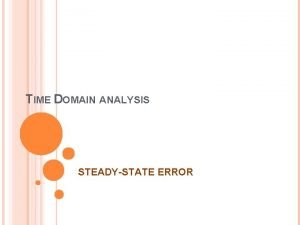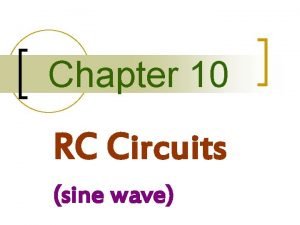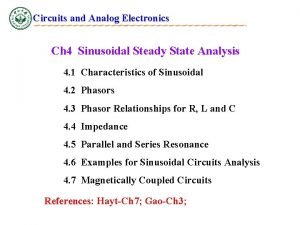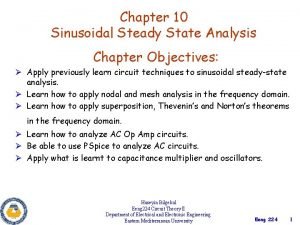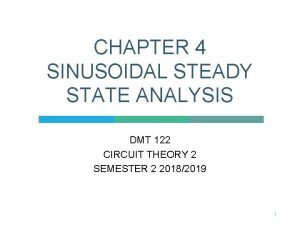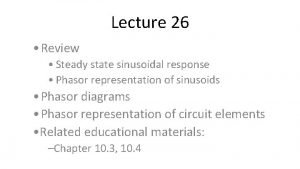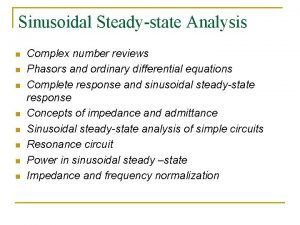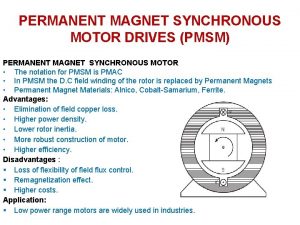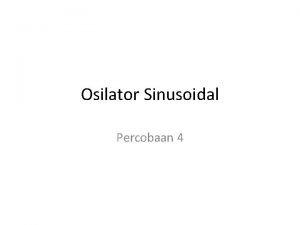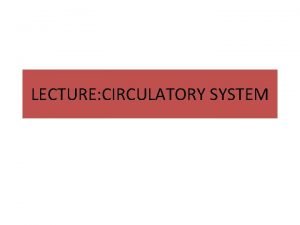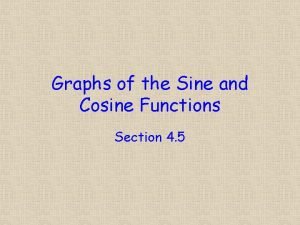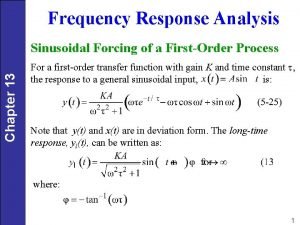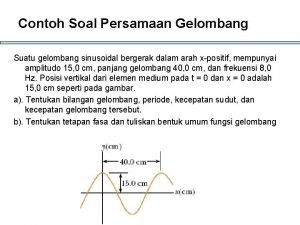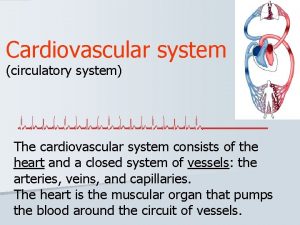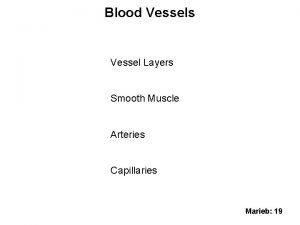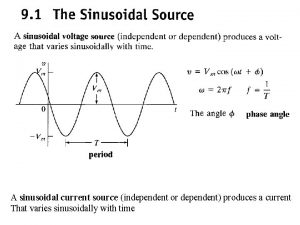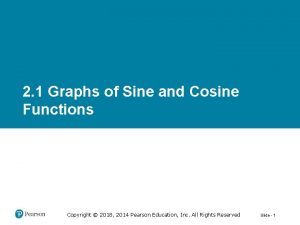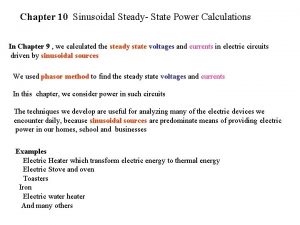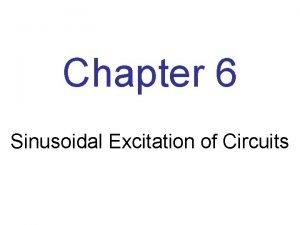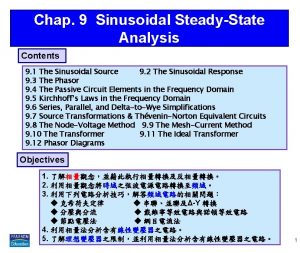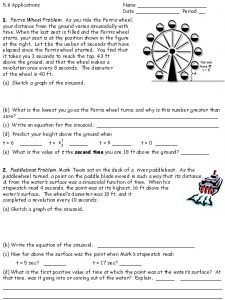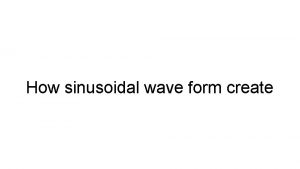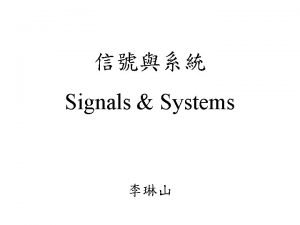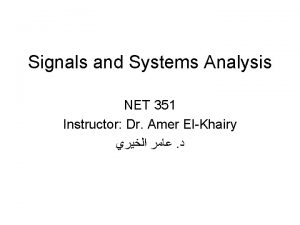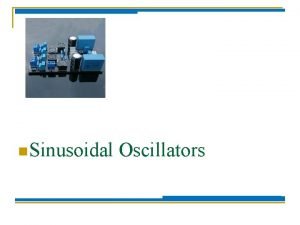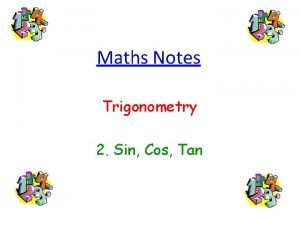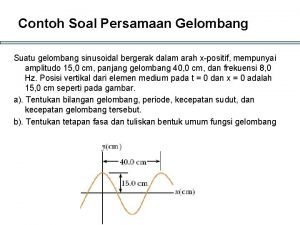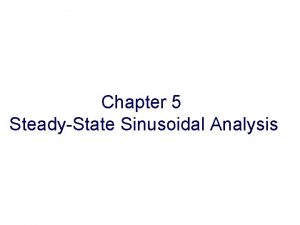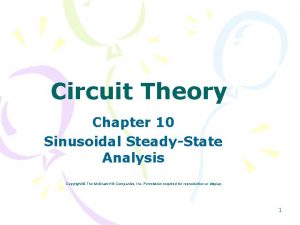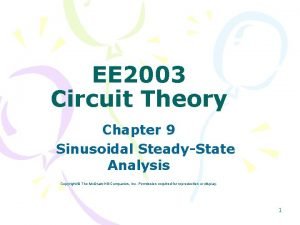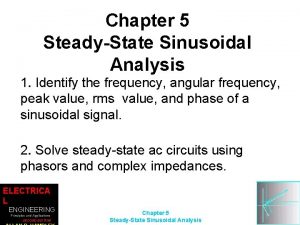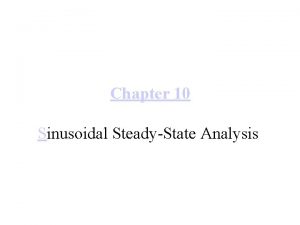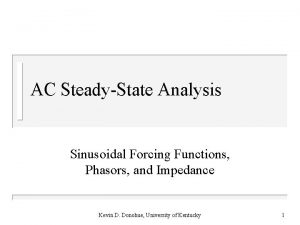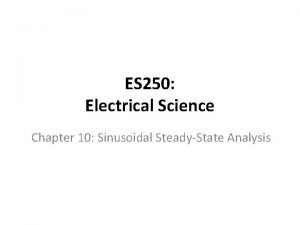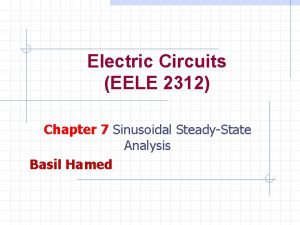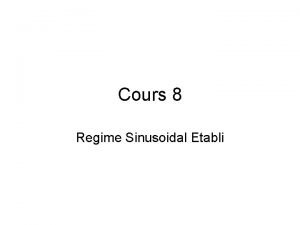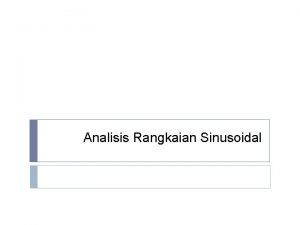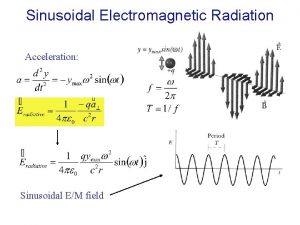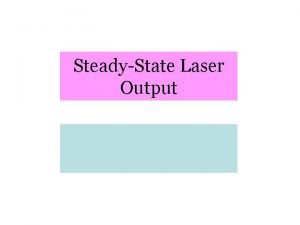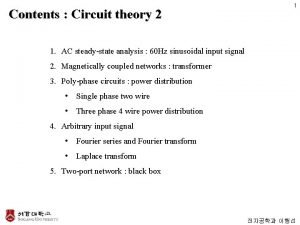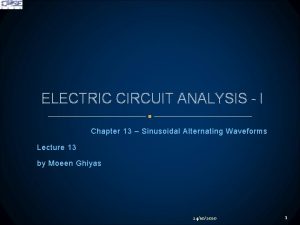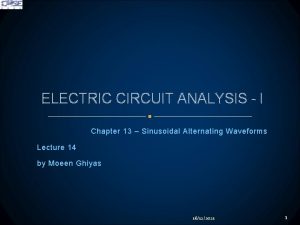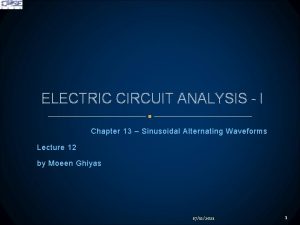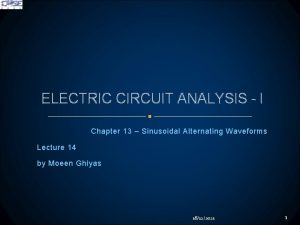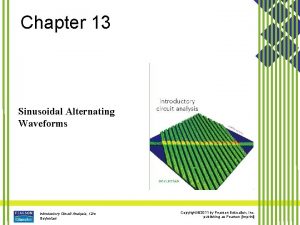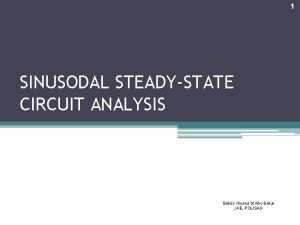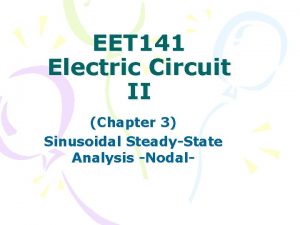AC Circuit Analysis Sinusoidal SteadyState Analysis Contents CHAPTER






















































- Slides: 54

AC Circuit Analysis Sinusoidal Steady-State Analysis

Contents (CHAPTER 10) Application of methods and theorem circuit to analyse the AC circuit eg • Nodal Analysis • Mesh Analysis • Superposition Theorem • Source Transformation • Thevenin and Norton Equivalent Circuits

Step to Analyze AC Circuits: 1. Transform the circuit to the phasor or frequency domain. 2. Solve the problem using method analysis or theorem circuit techniques. 3. Transform the resulting phasor to the time domain.

4 Independent Vs Dependent Sources • Independent sources: - The magnitude of the source is independent of the network to which it is applied & that the source displays its terminal characteristic even if completely isolated

5 Independent Vs Dependent Sources

6 Independent Vs Dependent Sources • Dependent/Controlled Sources: - One whose magnitude is determined (or controlled) by a current or voltage of the system in which it appears

7 Sources Conversion

8 Sources Conversion: Independent Sources

9 Sources Conversion: Independent Sources

10 Sources Conversion: Dependent Sources

11 Sources Conversion: Dependent Sources

Mesh Analysis Steps in determining mesh current for circuit contain with only independent voltage source: 1. Assign mesh currents i 1, i 2, …in to the n meshes Assign mesh current in the clockwise direction around each non redundant closed loop 2. Apply KVL to each of the n meshes. Use Ohm’s Law to express the voltages in terms of the mesh currents. 3. Solve the resulting n simultaneously equations to get the mesh currents by using substitution or determinants.

13 Mesh Analysis

14 Mesh Analysis The step if circuit contain with dependent voltage sources • Step 1 & 2 are the same as those applied for independent sources • Treat each dependent source like an independent source when Kirchhoff’s voltage law is applied to each independent loop. Once the eq. ready, substitute the eq. for the controlling quantity to ensure that the unknown are limited solely to the chosen mesh currents • Solve the resulting simultaneous linear equations

15 Mesh Analysis

16 Mesh Analysis The step if circuit contain with independent current sources • Step 1 & 2 are the same as those applied for independent sources • Treat each current source as an open circuit (recall the supermesh) & write the mesh eq. for each remaining independent path. Then relate the chosen mesh current to the dependent sources to ensure that the unknown of the final eq. are limited to the mesh currents • Solve the resulting simultaneous linear equations

17 Mesh Analysis

18 Mesh Analysis The step if circuit contain with dependent current sources • Step 1 & 2 are the same as those applied for independent sources • The procedure is essentially the same as that applied for independent current sources, except now the dependent sources have to be defined in term of the chosen mesh currents to ensure that the final eq. have only mesh current as the unknown quantities • Solve the resulting simultaneous linear equations

19 Mesh Analysis

20 Mesh Analysis

21 Mesh Analysis

Example (10. 3) • Determine Io in the circuit using mesh analysis


Method Analysis • Nodal analysis 1. Steps to determine node voltage: i. Select reference node. ii. Assign voltage respect to reference node) iii. Apply KCL to each nonreference nodes. Use Ohm’s Law to express the branch currents. iv. Solve the resulting simultaneously equations to solve for node voltage to the remaining n-1 nodes (with

Example 1(P. P 10. 1) • Find V 1 and V 2 in the circuit using nodal analysis 25 cos (2 t) A



28 Nodal Analysis

29 Nodal Analysis

30 Network Theorems (AC)

31 Superposition Find the current I using superposition theorem.




35 Superposition Find the current I using superposition theorem.



Thevenin and Norton Equivalent Circuit • Thevenin and Norton theorem applied to ac circuit in the same way as they are to dc circuit. Thevenin’s theorem states that a linear two – terminal circuit can be replaced by an equivalent circuit consisting of a voltage source VTH in series with a resistor ZTH, where VTH is the open circuit voltage at the terminals and RTH is the input or equivalent resistance at the terminals when the independent sources are turned off.

Norton’s theorem states that a linear two-terminal circuit can be replaced by an equivalent circuit consisting of a current source IN in parallel with a resistor ZN where IN is the short circuit current between two output terminals in the circuit and ZN is the total equivalent resistance at the terminals when the independent sources are turned off.

40 Thevenin’s Find the Thévenin equivalent circuit for the network external to resistor R



43 Thevenin’s Find the Thévenin equivalent circuit for the network external to branch a -a



46 Norton’s Determine the Norton equivalent circuit for the network external to the 6 ohm resistor in this figure.



49 Norton’s Determine the Norton equivalent circuit for the network external to the 7 ohm capacitive reactance in this figure.



52 Maximum Power Transfer


 Sinusoidal ctg
Sinusoidal ctg Steady state error in control system
Steady state error in control system Steady state error
Steady state error Sinusoidal response of rc circuit
Sinusoidal response of rc circuit Complex impedances
Complex impedances Sinusoidal steady state analysis solved problems
Sinusoidal steady state analysis solved problems Sinusoidal steady state analysis
Sinusoidal steady state analysis Steady state sinusoidal analysis using phasors
Steady state sinusoidal analysis using phasors Series vs parallel diagram
Series vs parallel diagram Different types of circuits
Different types of circuits Circuit construction kit
Circuit construction kit Current in series
Current in series Complete circuit and incomplete circuit
Complete circuit and incomplete circuit Current in parallel
Current in parallel Reflection and refraction venn diagram
Reflection and refraction venn diagram The circulatory system
The circulatory system Current in a parallel circuit
Current in a parallel circuit Content page magazine
Content page magazine Sinusoidal fetal heart rate
Sinusoidal fetal heart rate Sinusoidal steady state
Sinusoidal steady state What does peripheral resistance mean
What does peripheral resistance mean Pmac drives
Pmac drives Resonansi
Resonansi Smart bristow coil ppt
Smart bristow coil ppt Muscular artery
Muscular artery How to find midline of sinusoidal function
How to find midline of sinusoidal function Sinusoidal response of first order system
Sinusoidal response of first order system Subtle late decelerations
Subtle late decelerations Rate of energy transfer by sinusoidal waves on strings
Rate of energy transfer by sinusoidal waves on strings Suatu gelombang sinusoidal bergerak dalam arah
Suatu gelombang sinusoidal bergerak dalam arah Sinusoidal capillaries
Sinusoidal capillaries Fenestrated capillaries
Fenestrated capillaries Iupc contraction intensity
Iupc contraction intensity Sinusoidal current source
Sinusoidal current source Sinusoidal graphs
Sinusoidal graphs Sinusoidal real life examples
Sinusoidal real life examples Proyeksi peta dalam kartografi diperlukan untuk
Proyeksi peta dalam kartografi diperlukan untuk Sinusoidal pattern
Sinusoidal pattern Steady state current formula
Steady state current formula Sinusoidal excitation
Sinusoidal excitation Sinusoidal expression
Sinusoidal expression Extraterrestrial being problem sinusoidal
Extraterrestrial being problem sinusoidal Sinusoidal wave
Sinusoidal wave Classification of signals
Classification of signals Sinusoidal signal
Sinusoidal signal Sinusoidal oscillators are
Sinusoidal oscillators are Tan in trigonometry
Tan in trigonometry Fenestrations
Fenestrations Ada berapa gelombang
Ada berapa gelombang Suatu gelombang sinusoidal dengan frekuensi 500 hz
Suatu gelombang sinusoidal dengan frekuensi 500 hz Sinyal sinusoidal
Sinyal sinusoidal Cosine and sine graph
Cosine and sine graph Suatu gelombang sinusoidal bergerak dalam arah x positif
Suatu gelombang sinusoidal bergerak dalam arah x positif Define career portfolio
Define career portfolio Deep perineal pouch contents
Deep perineal pouch contents

